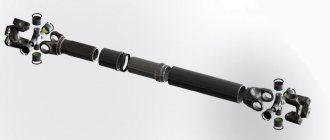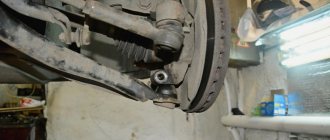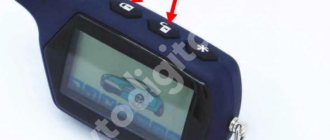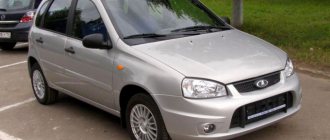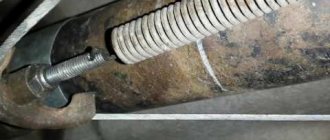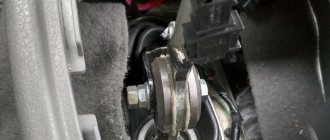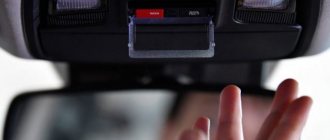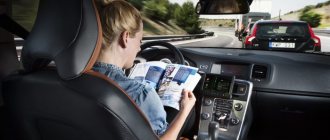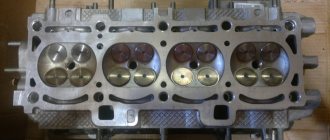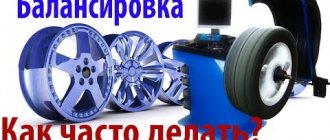Wheel balancing is the elimination of imbalance of a car wheel by shifting the center of rotating masses as close as possible to the axis of its rotation. The need for such a procedure arises when the mass of tires and wheels is displaced relative to their axis of rotation. Because the imbalance is transmitted to the car’s suspension elements.
Balancing the wheels on a car prevents excessive vibration of the steering wheel and body while driving, and also helps prevent deterioration in handling and premature wear of wheel bearings, ball joints and suspension silent blocks.
In this article we will talk in detail about when you need to balance wheels, how this procedure is carried out and whether you can do it yourself, as well as answer other frequently asked questions about wheel balancing.
What affects car wheel balancing?
It is almost impossible to ensure an absolutely accurate mass distribution relative to the center of the tire and wheel. Therefore, a slight imbalance is present even in new products. A deviation of a couple of tens of grams already has a negative impact on the behavior of the car during operation, giving rise to such problems as:
Example of wheel imbalance
- steering wheel beating and body vibration when driving;
- deterioration of controllability, deviation to the side from the correct trajectory;
- premature wear of wheel bearings, ball joints, suspension silent blocks;
- uneven and accelerated tire tread wear.
Eliminating this imbalance and related problems through compensating elements is exactly what wheel balancing does .
The symptoms and consequences of operating a car with unbalanced wheels directly depend on how much and in which direction the mass of the assembled wheel is shifted relative to the center of the rotation axis. Depending on this, three types of imbalance .
When is wheel balancing needed: causes and types of imbalance
| Type of imbalance | What causes | How does the car behave? | How the imbalance is corrected |
| Static (vertical) | Imbalance of the wheel vertically relative to the axis of rotation. | Radial runout of the wheel, slight swaying of the body on a vertical plane on a flat road, intense wear of the tire tread in one area across the entire width. | Static leveling is the installation of a counterweight at a point opposite to the point where the unbalanced mass is located. |
| Dynamic (longitudinal) | Displacement of the center of mass along the axis of rotation of the wheel. | Steering wheel runout at speeds of 40 km/h (tire imbalance on the front axle) or 100 km/h (tire imbalance on the rear axle), accelerated tread wear along the circumference on one side. | Dynamic compensation – placing weights to correct imbalances on the disc. |
| Combined | Imbalance in the vertical and horizontal planes. | Signs of dynamic and static imbalance are combined. | Use of compensating weights. |
a combined imbalance is most often observed , and the installation location of the compensation weights is chosen in such a way as to ensure balance on both axes. You can achieve the best result by changing the position of the tire on the rim. Sometimes this allows you to do without the use of cargo, but it requires significantly more time.
Elimination of wheel imbalance is possible with the help of microbeads - special granules poured inside the tire. However, due to the high cost of the latter and insufficient accuracy on small-diameter wheels, this method is not widely used.
What equipment is needed for the procedure?
Already during manufacture, the mass of tires is unevenly distributed around the axis of rotation - this is the so-called technological error. Further, during operation, the imbalance increases: the tire accounts for up to 75% of the imbalance, and the disks – up to 20%. The remaining percentage falls on the hubs with brake drums.
To get rid of imbalances, there is professional equipment - balancing machines (BS). Structures for diagnosing and adjusting rotating objects are permanently installed in tire workshops.
BS for wide-profile and ordinary tires are graded for installation without removing wheels with mechanical, electronic and combined measuring instruments. Another group of equipment is represented by stands that work with removed skates.
Balancing machine
The main elements of a high-precision stand for balancing passenger car wheels are a shaft with an electric (up to 800 rpm) or manual (up to 250 rpm) drive and a computer for data processing.
The technical process looks like this: the wheel is strung and securely fixed on the shaft, the computer system reads the initial information (width and height of the rubber profile, rim size). The shaft is spun, then the drive is stopped, allowing the wheel to rotate by inertia.
Next, pulse, dynamic and piezoelectric sensors are turned on, new data is recorded, from which the embedded program calculates the light points of the tire. All that remains for the master is to install the weights.
Some models of domestic and imported machines are equipped with laser systems that accurately show the location of the balancer.
How often should wheels be balanced?
The recommended frequency of wheel balancing is every 10–15 thousand kilometers . It is advisable to carry it out every time you change wheels seasonally. However, sometimes additional procedures may be required.
When do you need to balance your wheels more often?
How often should you do balancing: video
- After tire fitting . A prerequisite is to balance the wheel after each installation of a tire on a rim (including after repair) due to changes in their relative position.
- After falling into a hole or hitting an obstacle at high speed . Even if there is no visible damage to the tire or wheel, the balance of the wheel may be affected.
- During frequent braking with wheel locking on a car without ABS . Sharp braking leads to uneven tread wear, resulting in changes in mass distribution.
- With an aggressive driving style . Sharp acceleration and braking, and cornering, accelerate tire wear, thereby disturbing the balance of the wheels.
- When driving on bad roads . On roads with damaged or gravel surfaces, as well as off-road, tires also wear out faster.
- If vibrations occur in the steering wheel . Vibrations and beating of the steering wheel are one of the signs of imbalance.
- After the car has been idle for a long time . If the car has been sitting motionless for six months or more, then deformation of the rubber is inevitable.
How often to balance wheels also depends on the characteristics of the tires and wheels:
- Low profile tires need to be balanced more often as they are lighter and more susceptible to damage.
- The wider the tire relative to the diameter of the disc, the more susceptible it is to dynamic imbalance.
- Summer tires need balancing less often than winter tires. Winter tires are softer, so after warming up they wear out faster when braking and on bad roads.
- Studded tires must be additionally balanced if the studs are partially lost.
Is it possible not to balance the wheels when changing them?
Drivers often have a question: is it necessary to do balancing when replacing wheels and tires seasonally? If you have one set of wheels, the answer is clear: balancing is required every time the tires are reinstalled. If the second set of tires is on separate discs, then it all depends on the storage conditions of the rubber. Wheels may not be balanced if the following factors are met:
- Since the previous balancing, the tires have traveled less than 10 thousand km;
- before the last change of these wheels there were no vibrations or beating in the steering wheel;
- the wheels were stored in compliance with the rules: in a suspended state, maintaining pressure and without sudden temperature changes.
Damage due to shaking
If the imbalance is ignored for a long time, one or more technical components may break. Firstly, the rubber-metal elements of the chassis wear out faster. Unsprung masses experience vibrations the worst. Fastenings become loose and bearings break. The risk of damage to brake system components increases. For example, springs in drum brakes can jump out of their mountings.
Wheel bearings and CV joint fastenings often fail. Further, these damages affect most elements of the chassis and transmission.
Due to vibrations, electronic driving aids such as ABS and ESP work worse. Electronics malfunction and may show errors on the dashboard.
How to understand that wheel balancing is needed
An experienced driver can easily identify a significant imbalance of wheels, as it directly affects the behavior of the car.
Typical symptoms of imbalance:
Signs of imbalance in movement: video
- Vibrations and shaking of the steering wheel, progressing with speed.
- Deterioration in controllability, deviation from the correct trajectory.
- Uneven wheel noise when driving on a flat road.
- Vibrations in the rear of the car (imbalance of the rear axle wheels).
- The tire tread pattern has uneven wear and there are “bald spots” on it.
Similar symptoms can occur with steering and suspension faults. Therefore, if balancing does not help eliminate the problems, then these components should be diagnosed.
The need for balancing is indicated by the presence of defects in tires and wheels that were not previously present during a visual inspection.
Consequences of lack of balancing
The consequences of driving on unbalanced wheels can range from mild to very serious and even dangerous. Typically, wheel imbalance results in:
- The steering wheel wobbles when driving.
- Fuel consumption increases.
- The car's handling deteriorates.
- There is noise in the cabin when driving.
- Tires begin to wear out quickly and unevenly.
- Suspension elements quickly fail.
Many of these symptoms can not only lead to additional car repair costs, but also cause an accident.
The principle of balancing wheels on a car
The general principle of wheel balancing is to detect deviations from the uniform distribution of mass relative to the center of the wheel and eliminate them by moving the tire and wheel and/or adding weights. If there are disc deformations, they are first corrected, and only then the balance is restored. Before performing the procedure, it is necessary to wash the surface of the wheel and remove small stones and other objects from the tread that may affect the weight distribution.
To perform vertical balancing, you need to find the lightest points on the circumference of the wheel and weigh them down. For longitudinal balancing, it is necessary to detect points that cause a displacement of the vectors of inertia forces, and similarly balance them by hanging weights. Tire offset helps less in this case, because it is usually the tire, and not the disk, that is more involved in causing the imbalance.
How to do wheel balancing
There are 4 main ways to balance car wheels, depending on the equipment:
Balancing wheels on professional equipment: video
- Static (manual) balancing . The wheel is mounted on an axle that allows free rotation and allows detection of mass displacement. To search for statistical imbalance, the wheel rotates in the vertical plane, while dynamic and combined imbalances rotate in the horizontal plane. If there is an imbalance, the wheel will constantly fall towards the point of overweight. The technology is simple and accessible, but has low accuracy ; the quality highly depends on the qualifications and experience of the master. Today, such a service is not provided by professional service stations, but can be found in garage workshops.
- Dynamic balancing on a stand . The wheel is fixed to the axis of the balancing stand, after which it is rotated, during which sensors detect and measure the imbalance. Next, the operator independently or based on the stand’s prompts (if this function is available) selects their installation locations. The procedure ends after the imbalance is zero.
- Automatic powder balancing . The wheels are filled with a special powder (also known as granules and beads), which, under the influence of centrifugal forces, is distributed over the inner surface of the tire and balances the wheel. Under the influence of a static electric charge generated by friction, the powder adheres to the wheel and is held at the desired points. The method allows you to quickly balance the wheels of heavy equipment, it is relatively simple, but the granules themselves are expensive, their correct dosage is required depending on the size of the wheel and the magnitude of the imbalance.
- Final balancing on the car . The car wheel is jacked up and a balancing device equipped with a roller and sensors is attached to it. The roller spins the wheel to speeds of about 90–100 km/h, and sensors record the magnitude of the vibrations that occur and calculate the load attachment points and their mass. Since the hub, the brake drum or disc, and the drive axle shaft rotate together with the wheel, this balancing technology makes it possible to balance all arising inertial forces as accurately as possible and eliminate runout. The advantage of the method is high accuracy, the disadvantages are low prevalence and high price.
The table below presents a comparison of wheel balancing methods, which will help you weigh their pros and cons and find out which balancing of passenger car wheels will be the best choice, and what is the best way to balance truck wheels.
How wheels are balanced: description and comparison of technologies
| Balancing method | Advantages | Flaws | Peculiarities | Average price for the season* 21–22, rub. |
| Installing balance weights manually |
|
| Due to its low accuracy, the method is suitable for balancing small passenger wheels on cars moving at a speed of no higher than 100 km/h. | Free (only costs for weights) if done independently. Almost never found in professional services. |
| Adding balancing powder to the tire |
|
| Suitable only for vehicles with wheels with a diameter of 15 inches or more due to low accuracy. |
|
| Dynamic balancing of a car on a stand |
| Weights get lost when driving on bad roads and during washing, spoiling the aesthetic appearance of the wheel | The most common balancing method. Optimal for cars of all classes. |
|
| Final wheel balancing directly on the car |
|
| Recommended for fast sports cars, not available for heavy equipment (trucks, buses). |
|
*Average prices are indicated for two balancing of 4 wheels per year, when switching from summer tires to winter tires and vice versa.
**Before final balancing, a “rough” dynamic balancing may also be required to eliminate the most pronounced imbalance.
How to carry out the procedure correctly
With an imbalance of 10-15 g, the suspension receives thousands of blows per minute, which is comparable to the effect of a jackhammer on concrete. To prevent the negative consequences of poor tire weight distribution, proper tire balancing is necessary.
Why is the preparatory stage important and what does it include?
Wheels need to be balanced as an assembly when the tire is placed on the rim. A mandatory rule is the preparatory stage, on which the final result of the procedure depends.
Preparatory stage
Do the following:
- Wash the rim on both sides, otherwise pieces of dirt will show the uneven weight of the rubber around the circumference.
- Clean the tread of stuck stones (especially important for trucks and SUVs). Stones and gravel between the blocks of the tire treadmill make certain sections heavier: balancing will be inaccurate.
- Remove old weights and trim caps from the rims.
Make sure that the tire sits tightly in place: this has a strong impact on the performance of balancing devices and instruments.
Types of balancing
The procedure is carried out in several ways. There is balancing of car wheels on a machine with tire removal and directly on the car. There is also automatic balancing using granules or powder.
Wheel balancing granules
Granules with a diameter of 0.15-0.9 mm have a heavy glass or ceramic core inside, and the outside elements are coated with silicone.
Beads are poured into the tire cavity: under the influence of centrifugal forces, the beads are distributed and stick to the rubber in large quantities where the weight is less. This results in automatic self-balancing, which, however, is not popular among drivers.
Static
Static (vertical) imbalance is eliminated by all tire fitting stations. But this is the simplest type of balancing, which, in order to save money and time, car enthusiasts often perform in the garage.
The essence of the operation is to identify a heavy section of the tire that hits the road with greater force, unevenly wearing out the tread and having a destructive effect on the chassis and suspension.
Static balancing
To eliminate static imbalance, compensating weights are hung on light points over the side edges. Product weight – from 5 to 60 grams, material – lead, steel, zinc.
Repair devices are attached to stamped discs with brackets, and to cast and forged discs - with Velcro. The latter are unreliable in winter: they can fall off in the cold. But there are a number of disks on which no other method of securing loads is provided.
Dynamic
The larger the tread in the cross member, the easier it is to “earn” dynamic imbalance when moving (“figure eight”) and the harder it is to get rid of it. It is impossible to eliminate the intersection of the axes of inertia and rotation on your own - the matter is entrusted to professionals. The air pressure in the tires for any type of balancing must be normal.
Finish
Such wheel balancing should be done after eliminating static and dynamic imbalance, as well as when changing tires.
Final balancing
The final procedure for leveling the tire balance is carried out directly on the car: an electronic device is installed under the bottom, the wheels are spun to 80-90 km/h. Sensors automatically take measurements and indicate places where weight needs to be added to the rim.
Methods for balancing without removing wheels
When vertical vibration of the body occurs from wheel bounces, drivers eliminate it in the garage. The process is the same as at a service station, but you will spend more time because you will have to try on weights of different weights several times. The old-fashioned method, “by eye,” gives the same effect as in the workshop.
Prepare a jack, self-adhesive balancing weights or weights on brackets. You'll need chalk or a marker to mark easy spots, as well as a hammer to secure the padded weights.
Don't skip the preparatory stage with washing the wheels and cleaning the tread from stones and gravel. Remove the plastic covers.
Further work:
- Raise one side of the car on a jack, secure it from rolling back and falling.
- Determine the location for installing the balancing weights: untwist the ramp in one direction, after stopping, mark the top point on it with chalk, focusing, for example, on the middle of the wheel arch.
- Rotate the tire in the other direction and repeat the manipulation with the chalk.
- Evaluate the placement of the chalk marks: the middle between them is the desired easy point.
- Install weights in this place, starting with the light ones.
- Keep spinning the wheel. If after stopping the weights are at the bottom, balancing is successful.
- Now start moving the weights in different directions. The task is to ensure that after the next spins and stops the weights end up in different positions.
- Secure the items with a hammer.
Methods for balancing without removing wheels
Balancing may not work out the first time. Make lighter areas heavier by adding weight. Follow the sequence of actions with other tires, then test the wheels for balance by driving 10-15 km at a speed of 80-90 km/h. If you didn’t feel the car jumping or the characteristic knocks on the steering wheel, you did everything right.
How to balance a set of tires at home?
DIY balancing device
If a tire service is unavailable or if you want to save money, you can balance the wheels yourself using a machine that can be assembled in a garage. The simplest garage balancing stand consists of a hub securely mounted on a rigid support with a flat base.
Balancing must be done in the following order:
- Fasten the wheel, cleaned of dirt, to the hub and spin it by hand.
- During rotation, observe the beating of the rubber, the “figure eight” of the disk.
If there are strong pronounced deformations and runout, balancing is unlikely to help. - Wait until the wheel stops and is balanced, put a chalk mark at the top point.
- Turn the wheel 90 degrees (a quarter turn) in both directions several times, waiting for it to stop after each turn.
- If the wheel is in a different position each time, there is no pronounced static imbalance, it is “conditionally balanced.”
- If the mark is always at the top, the main point of imbalance has been identified, you can begin to eliminate it.
The faster the wheel returns to the top position, the more weight is needed. Its exact value can only be predicted experimentally. Without experience, you can start with a load weighing 20–30 grams. - To eliminate the imbalance, you need to hang (without fixing it securely) a weight opposite the mark and repeat step 4.
- If, after hanging the weight, the mark still appears at the top, its mass must be increased; if it now goes down, it must be reduced.
- It is necessary to adjust the weight of the weights until the wheel, after spinning 90 degrees, stops in any position. When the optimal set of weights has been selected, they can be fixed.
For a more uniform distribution of masses, you can use several weights: for example, instead of one for 40 grams on the outer side, attach 20 gram weights on the outer and inner sides opposite the mark.
The described method is a static balancing designed to shift the center of mass of the wheel as close as possible to the axis of its rotation. It allows you to eliminate very large imbalances with an accuracy acceptable for cars that do not drive fast, but is not suitable for fine adjustments of balance. This is acceptable wheel balancing for VAZ classics and other similar models.
More accurate balancing of car wheels at home is possible using a “spinning top” shaped device. The tool can be made on a lathe from a solid steel blank (moreover, steel is harder than the common ST-3) with a diameter of about 150 mm, so that the structure is monolithic and balanced.
Aluminum and other soft metals are not suitable because the ends of the spindle axle must be rigid and not deform or become dull under the weight of the wheel!
The tool should have a slight taper on one side that turns into a thread. The conical shape is needed so that the wheel self-centers when the nut is tightened.
The balancing process is carried out as follows:
Balancing a wheel at home: video
- Place the “top” in the central hole of the disk and tighten it with a nut.
- Place the wheel with the tip of the “top” on a flat, hard surface or in a stand with a recess.
- Move the wheel and release it, controlling the position in space. A balanced wheel should independently occupy a horizontal position and return to it after rocking. If there is an imbalance, it will not stay “in the horizon”.
- If an imbalance is detected, you need to take a weight and place it at the highest point of the wheel, and then repeat step 3. If the same section still rises with the load, its mass must be increased; if it begins to fall, decrease it.
- The weight of the weights is selected until the wheel on the spoke begins to take a horizontal position and returns to it after each rocking. The static balancing of the wheel is completed, and if high accuracy is not required, then it can be placed on the car. If you also need to eliminate dynamic imbalance, then you need a rigid tripod (for example, a laboratory one) with chalk and the following further actions:
- The wheel is manually spun on the top to the maximum possible speed.
- With the help of a small wooden block, lightly pressed against the upper edge of the top, the vibrations introduced during spinning are dampened.
- The tripod arm with the chalk attached is smoothly brought to the wheel rim until it makes the first contact.
- After several revolutions of the wheel (and touching the chalk), you need to stop it and see at what point the chalk touches the disk.
- At the point where the chalk touches, a weight should be secured (the weight is selected experimentally), and a second weight of the same weight should be secured on the diametrically and diagonally opposite side of the rim. This is necessary to prevent static imbalance.
- Experiment with the weights until the beating of the wheel goes away and it stops touching the chalk with one point.
Self-balancing in a garage cannot fully replace the procedure on modern equipment due to low accuracy. Therefore, if possible, it is better to visit a service station and eliminate the imbalance completely. This is more reliable, and taking into account the considerable labor required to balance large wheels, it is also much easier.
Basic mistakes when balancing wheels
Mistakes made when balancing wheels can result in the imbalance not being completely corrected. As a result, while driving the car, the same symptoms may occur as before the procedure.
The main signs of improper wheel balancing and how to eliminate them are presented in the table.
Poor wheel balancing: signs
| Balancer error | Why is this happening | How to determine | How to fix |
| Balancing when there is dirt on the wheel or moisture inside the wheel | Adhered dirt, foreign objects lodged in the tread, and water inside the tire create inconsistent imbalances. | The wheel is not brought to zero on the machine, the imbalance is not completely eliminated | Wash the wheel thoroughly, remove foreign objects from the tread |
| Balancing a wheel with a broken tire or wheel geometry | The tire is deformed due to abnormal loads or violation of storage conditions |
| Replace a defective tire or wheel |
| The disc is deformed, its core is displaced relative to the rim, a “figure eight” appears | |||
| Incorrect torque of the hub bolt on the balancing machine | Deformation of the central center of the disk |
| Correctly fix the wheel on the machine hub and recheck the balance |
| Weak disk tightening on the machine hub | |||
| Incorrect selection of centering cone | |||
| Violation of technology for installing a tire on a disk | Misalignment of mark and nipple | Many tires have a colored manufacturer's mark at the point of lightest weight, which should be located near the valve. | Orient the tire on the rim so that the mark is near the valve |
| Poor quality side lubrication | The technician did not apply a special compound to the tire beads, which is why their fit is noticeably poor. There may be some beating noticeable to the naked eye. | Coat the beads with a sealing compound and inflate the wheel to maximum operating pressure. | |
| Insufficient pumping | The tire did not press tightly against the rim due to lack of pressure. | ||
| Misalignment when installing a wheel on the vehicle axle | Tightening bolts or nuts in a circle | The wheel on the machine shows normal balance (“to zero” or an imbalance of less than 5 grams), but after balancing the wheels there is still vibration. | Unscrew the wheel and re-tighten it to the hub, tightening the bolts or nuts crosswise diagonally, observing the torque specified by the car manufacturer |
| Uneven tightening of bolts or nuts around | |||
| Failure to secure the machine | Unreliable fixation of the machine on the ground (on a concrete base, using anchors) | In the process of spinning the wheel, the machine itself begins to vibrate, and the floor in the workshop hums. | Balance the wheel on a machine fixed in accordance with the rules for its installation and operation |
| Poor fixation of weights | The master did not fasten the weights securely enough, without pressing them to the side or without treating the surface of the disk for gluing | Soon after balancing, vibration arose again, there are no weights on the wheel, traces of fallen weights are visible (on the alloy wheels). | Re-balance the wheel and securely secure the loads. For stamped disks - check the clamping of the weights; for cast disks - clean the surface before installing the weight on an adhesive base |
| Inaccurate balancing | The master did not set the imbalance indicators to zero, leaving a slight runout | Small vibrations still appear at speed. The balancing stand shows an imbalance on one side of more than 5 grams. | Rebalance the wheel. |
| Excessive amount of cargo | The imbalance measurements were made inaccurately, which is why the number of weights and their mass were selected in excess. The tire is not aligned relative to the rim. | The total weight (for a passenger wheel) is more than 70 grams on each side. | By moving the tire relative to the disk, select their optimal position, in which less weight is needed. Have the wheel balanced on a more accurate machine and/or by a more experienced technician. |
| The tire or disk has critical deformations | Replace a defective tire or wheel |
Why are wheels balanced?
After installing a new tire, radial runout occurs in the disk, caused by a mismatch between the center of gravity and the axis of rotation. To compensate for this defect, balancing weights are attached to the disk to ensure uniform rotation of the rim. The wheel is placed on a balancing machine, which rotates the disk and records the radial runout. The position of the compensating weight is determined experimentally.
The essence of the procedure for restoring balance comes down to aligning the disk with its geometric axis, which is in line with the center of the drive shaft. The alignment of structural elements is a necessary condition for comfortable and safe operation of the vehicle. If the axes of the “shod” disk and the drive shaft do not coincide, the driver and passengers of the car find themselves in an extremely unpleasant situation with far-reaching consequences.
FAQ
Why is wheel balancing done?
Wheel balancing prevents wheel runout, which negatively affects handling and ride comfort, and also shortens the life of tires and suspension parts.
How often should wheels be balanced?
The average wheel balancing interval is 10,000–15,000 km. Wheels also need to be balanced when reinstalling a tire on a rim or after a severe impact to the wheel as a result of falling into a hole or hitting an obstacle.
What happens if you don't balance your wheels?
Wheel imbalance leads to increased vibrations when accelerating, deviation from the correct trajectory, accelerated wear of the tread, hub bearings, ball joints, silent blocks and other parts in the suspension.
How to check wheel balancing?
To balance wheels, it is best to use a professional stand, which will accurately detect points of imbalance and determine its magnitude.
How to recognize unbalanced wheels?
Unbalanced wheels cause vibrations and beating in the steering wheel, increase tire noise, and can cause the car to sway vertically on a flat road.
Is it necessary to balance the rear wheels on front wheel drive?
On front-wheel drive cars, the drive wheels suffer more as they take turns. Countless maneuvers eat up the sidewalls of the tread. But the rear slopes are also subject to mechanical deformation. If the front wheel flies into a hole, then the rear wheel will fall into the same place, causing a blow to the suspension.
The imbalance in the front is more pronounced, while the rear becomes more noticeable at speeds above 120 km/h. But balancing must be carried out simultaneously on all wheels, regardless of the installation location.
